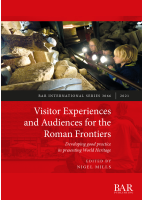Description
This edited volume explores developing practice in the public presentation of the World Heritage of the Roman frontiers. Written by leading European practitioners the emphasis is on developing experiences that are visitor focused rather than academic, whilst respecting authenticity. The originality of the book lies in this visitor-centric approach and in the combination of strategic and operational examples from one strategic area of interest - the World Heritage of the Roman frontiers. This enables the reader to make comparisons between different approaches and solutions. The book covers three main areas of interest: strategic planning and policy, practical applications and issues of authenticity and public perception. The book will interest researchers, teachers and practitioners across different parts of the world in fields including heritage management and interpretation, cultural tourism, visitor studies and museology.
Preface by René Ployer, one of the three authors who developed and wrote the Thematic Study and Proposed World Heritage Nomination Strategy for the Frontiers of the Roman Empire.
EDITOR
Nigel Mills is a consultant in heritage interpretation and management and sustainable tourism. He studied archaeology at the Universities of Cambridge and Sheffield and has a PhD in landscape archaeology. His professional career includes positions as Director of Creswell Heritage Trust and Director of World Heritage at the Hadrian’s Wall World Heritage Site.
Contributors: Mike Bishop, Kevin Booth, Boris A. N. Burandt, Rob Collins, Erik Dobat, Christof Flügel, Snežana Golubović, Erik Graafstal, Bill Griffiths, Freek Hasselaar, Tom Hazenberg, Richard Hingley, Nigel Mills, Mark Nixon, Tijn Pieren, Andrew J. Roberts, Kerry Shaw, Catherine Visser, Patricia Weeks
REVIEWS
‘The chapters are without exception engagingly written, and the diversity of case studies across different frontiers and national heritage contexts is a great strength of the work. (…) This volume will therefore surely provide thought-provoking reading for any individuals and organisations involved in the care and presentation of Roman archaeology.’ Antony Lee, Theoretical Roman Archaeology Journal 6(1), 2023
‘Valuable reading for all those involved in heritage interpretation.’ Michael Hamish Glen, Interpretation Journal, Association for Heritage Interpretation, 2022
‘The essays radiate a can-do energy, which is a welcome ray of hope after three years of Covid-induced depression and today’s bleak wartime perspective. We need this energy more than ever.’ Jan Hochbruck, EXARC Journal 2022/2
‘The future prospect of extending the Roman frontiers as a UNESCO World Heritage site in Asia and Africa as stated in the Introduction as well as the importance of UNESCO World Heritage in several of the chapters make this book relevant for readers, researchers and policy makers outside Europe. This book revived my enthusiasm on the topic, bringing back my experience in the field of museums and visitors some years ago.’ Dr Renger de Bruin, Universiteit Utrecht
‘The Romans are long gone but they remain with us in spirit. However, their presence and activities along their frontiers are often misconceived, misrepresented and inaccurately explained to visitors. Nigel Mills has assembled these readable but scholarly essays that describe the many, sometimes conflicting, reasons for these shortcomings. These essays also set out how excellent strategic and site-specific interpretive techniques can counter the inadequacies and paint an authentic, engaging, inspiring and, crucially, an accurate picture of a fascinating era in the story of Europe. Their lessons apply widely and make this book valuable reading for all those involved in heritage interpretation.’ Michael Hamish Glen, Wordsmith / Trustee, Association for Heritage Interpretation
'Mediation work is a process that needs continuous adaptation and development for which the mutual exchange and reporting of experiences between those involved is vital. This is exactly what Nigel Mills achieves in his highly successful sessions that have been a feature of the Limes Congresses since 2009, and also in this book in which he brings together colleagues from different sections of the Roman frontiers. Through 14 contributions, 19 authors explore the idea of heritage interpretation and especially the development and application of the Interpretation Framework methodology. The papers explore strategic aspects, report on showcase projects and also warn against too hasty and ill-considered approaches - collectively they aim to convey ideas and approaches that can lead to successful interpretation of the complex heritage landscapes of the Roman frontiers.' From the Preface by René Ployer Federal Monuments Authority Austria, Archaeology Department.











